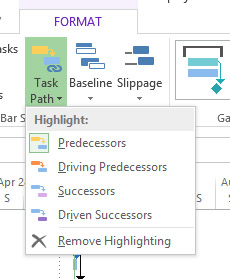Tracing Task Paths in Microsoft Project 2013
Synopsis: In this article, we look at the new Task Paths feature of Project 2013. This enables you to easily identify which other tasks impact or are impacted by a specific task.
In a complex project, it can be difficult to identify which tasks impact or are impacted by a specific task that you’re dealing with.
For example, suppose that you are concerned about the consequences of delaying the completion of a task and want to see which other tasks the delay will affect.
Whilst at the time you are looking at this you can identify tasks that are on the critical path for your project, you may also want to be able to easily identify other tasks that may become critical with further delay.
This project schedule relates to the building of a house and the current view is the Gantt Chart.


The task Structural steel is selected. On the Format tab in the Bar Styles group click the Task Path button. Click that and select Predecessors.


What you can now see are all of the predecessors of the selected task with their Gantt bars colored yellow. Note that this display is only telling you that the tasks are predecessors, not that they are in some way critical.
When you click on the Task Path button you actually see four options for what can be shown in the Gantt Chart.


With each option, there is an icon on its left that shows what color highlighting will be applied if you select that option. A border around an icon indicates that its option is currently in force, so in the example above Predecessors is currently in force but not the other options.
You can select any combination of the four options. If you select both Predecessors and Successors the Gantt Chart looks like this.


What is sometimes of most interest is to know which predecessors directly impact a task. A driving predecessor is one which will potentially cause a change to the scheduling of the selected task if its schedule changes.
Whether it actually causes a change in a specific situation depends on the nature of both the dependency between the tasks and the change to the driving predecessor.
See what happens if you select the task Roof structure and tile and show both predecessors and driving predecessors.


In this case, most of the predecessors are driving predecessors, but Trussing – which is colored yellow – is not. That means that a certain amount of delay in the Trussing task will not immediately delay Roof structure and tile, as there are other predecessor tasks that the selected task’s schedule is being driven by.
With Roof structure and tile still selected, if you now show driven successors you will see several tasks colored purple. These tasks are the ones whose schedule is directly driven by Roof structure and tile.


To stop tracing task paths you can switch them off individually using the options on the Task Path button, or you can select the final option available from that button which is Remove Highlighting.


